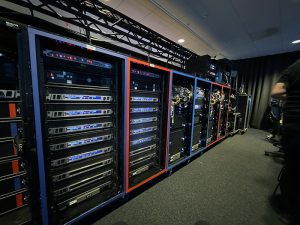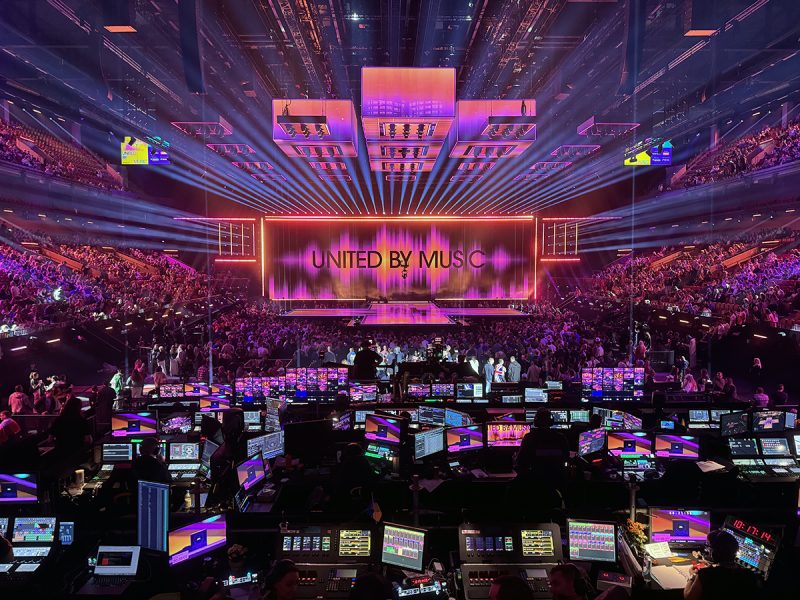Speaking exclusively to TPi’s Jacob Waite, Joe Bleasdale, Megapixel Product Marketing Strategist, shares how in collaboration with NEP Sweden and Creative Technology (CT), the Eurovision Song Contest 2024 upgraded from a traditional baseband system to a fully redundant 100G ST 2110 network for its video distribution and LED displays using Megapixel’s newly released 100G input module for HELIOS.
Having first featured at the Eurovision Song Contest in Rotterdam in 2021, and on multiple productions since, 2024 marked Megapixel’s first edition as an official Technical Supplier. “This year, the production team wanted to do the whole show on 2110, which has never been done before,” Bleasdale began.
Typically, most shows use either SDI or HDMI, and occasionally DisplayPort for the video system, given the configuration of most video matrices. This comes with its own unique set of challenges, namely, the economy of space backstage. ‘Video world’ usually has a wider footprint than most technical departments and for a production as complex as the Eurovision Song Contest, with a large team involved, any decrease in space and advance in technology is considered a “net positive”, according to Bleasdale.
“CT had already successfully deployed 2110 with HELIOS before, on projects such as the Ryder Cup, and had made a great deal of investment in 2110 infrastructure over the previous year’s allowing them to transition from HDMI and SDI to 2110 smoothly, so they were already very well versed in the benefits of using a network topology for the LED system,” Bleasdale said. “Last year, we released our 100G fibre input model for HELIOS, we made this module specifically so users could ingest up to four 4K or 8K rasters on a single fibre input. Not many media systems have transitioned to an 8K workflow yet, but we built this module in anticipation of the future and thanks to the modular nature of HELIOS, it’s an easy upgrade for existing customers, meaning their investment in the platform is protected for many years to come.
In collaboration with CT, Megapixel provided some of these new modules for Eurovision’s mandatory red and blue (an A and B) system which ran on the 100G input modules, fed from disguise media servers into its network monitoring system and back into both HELIOS racks. “HELIOS powered almost all the LED on the show, namely, the ROE Black Quartz back wall, the Black Marble floor and Vanish tiles on the cubes. We had two racks with seven HELIOS in each both running our newly released SeamlessLoop redundancy mode for an additional level of redundancy,” he noted.
The entire network was monitored by CT’s network monitoring system in addition to Megapixel’s OMNIS monitoring system. “We started work with CT early in the year, with Christian Dickens from Megapixel working closely with the CT team in London. Once we got 2110 up and running, which was done in the early tech stages, it was solid. We provided the production team with some custom software builds to make their life easier, as part of our commitment to the show, and this enhanced functionality is available now in our latest release” Bleasdale explained.

“Working on shows of this calibre, directly with the end customer yields an unprecedented amount of validation and feedback for the software team. It means we can iterate quickly, and push builds out to the team onsite making their workflow as slick as possible, which on larger productions, is a big deal.”
Megapixel released SeamlessLoop last year, which meant that even if a cable was cut, the system would still work. “Halfway through the tech rehearsals, the crew decided to change the redundancy mode from what was originally planned to SeamlessLoop mode, marking the first time we’ve used this mode on this scale, and we encountered no issues whatsoever,” Bleasdale proudly recalled.
There are a lot of people from the production team who have been involved in Eurovision for many years, and every year the team experiment with new technologies on the biggest stage, so for technical suppliers, it is paramount when the production reaches 10 days from the finale – when the ticketed rehearsals and semi-finals begin – everything has to work not only in front of a live audience, but for those tuning in from around the world, as these stages of the contest are treated with the same respect as the grand finale.
“Everything must be locked in at that point, and fortunately for us, with the video system being so vast, our delivery was consolidated in advance. Eurovision is one of the few shows with a 24/7 production crew, so there is a lot less room for error – a lot of shows don’t get that luxury,” Bleasdale acknowledged.
With the LED, media server and video crew all sat next to each other in video world, the bulk of the video world was built early in the process before Megapixel arrived on site. This was made possible thanks to the early-stage planning and communication between Megapixel and CT.
“One of the key things people don’t appreciate about the Technical Supplier agreements with Eurovision, unless you’re directly involved, the reality is when you’re signing that dotted line, you are committing to making the production work, regardless of the complexities involved, and to fail is to fail on the greatest stage of them all,” Bleasdale said, further underlining the importance of advance planning. This year, cyber security was also a key factor for the production. “HELIOS is designed with cyber security in mind, there’s a lot of security built-in such as support for SSH credentials thanks to our extensive work with large corporate companies. For Eurovision, the production doesn’t allow anything to be on an internet connected network anyway, which is smart, and there is a dedicated team covering networking security and management.”
Eurovision also marks the perfect place to demonstrate technical ingenuity. “You can do a 2110 show without the budget of Eurovision, but we did it on the biggest one, to showcase that it is truly scalable. I’m hoping that this event encourages the transition from HDMI and SDI to 2110 in live events – it’s going that way with the influence of modern-day media servers which can now output 2110 natively too. Other industries have gone full network based, so I believe it’s only a matter of time before touring does too.”
In closing, Bleasdale reflected more broadly on the wider significance of the Eurovision Song Contest on the events calendar, following the crowning of Swiss singer, Nemo’s rendition of The Code on the night. “A decent song with a good message won, and they are a country which hasn’t hosted the contest for over three decades, so they deserved to win. In terms of technology, as someone with a lighting background, I was really impressed by the Follow-Me system, and the incorporation of augmented reality. AR has been overused in recent years but the inclusion of it this year was so well composited within the broadcast output, aiding the overall production as a storytelling device,” he concluded. “Ultimately, doing Eurovision on ST 2110 was a great way of underlining the capabilities of 2110 and if it works on a production on this scale, it can work anywhere…”


